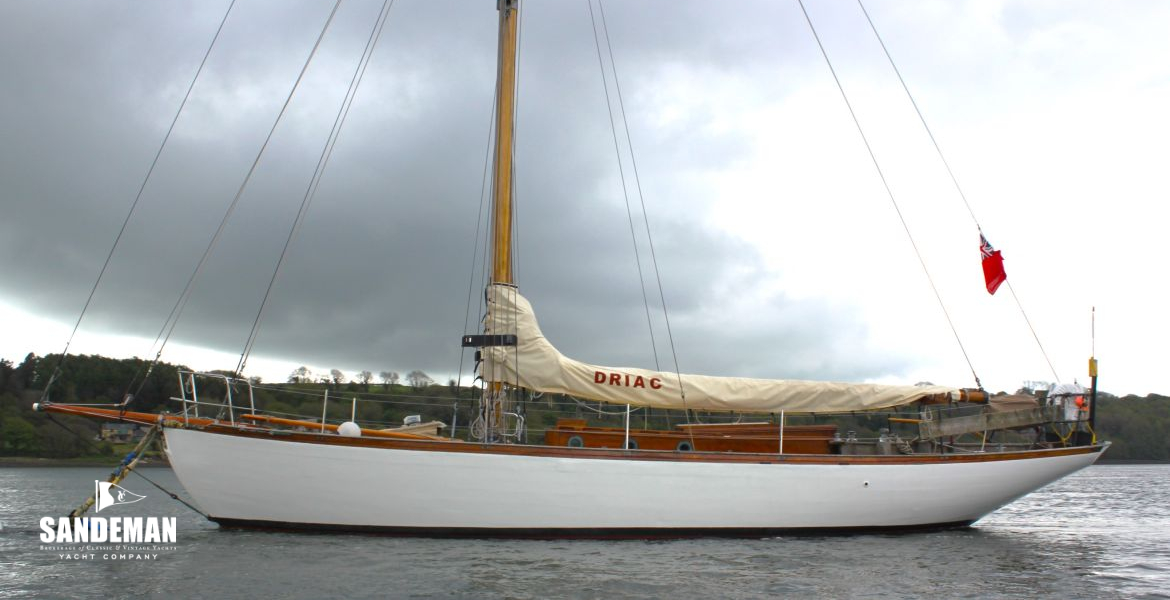
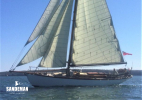
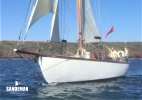

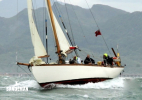
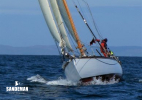

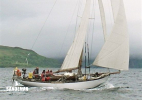
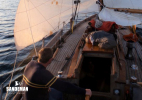
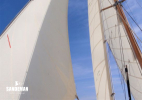
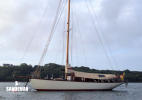
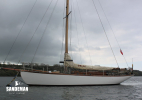
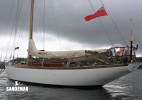
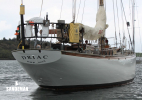
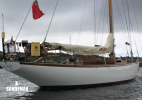
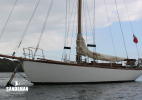
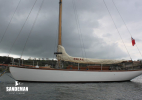

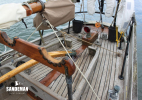
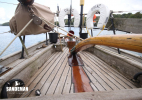
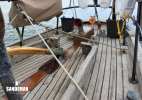
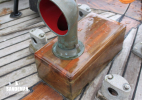
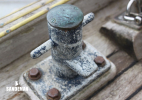
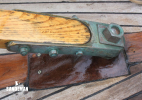
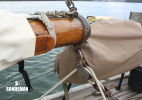
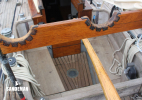
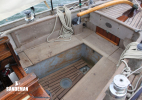
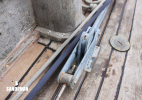
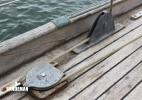
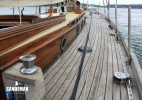
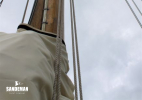
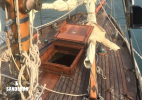
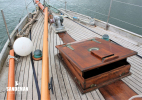
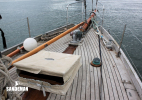
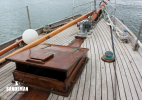
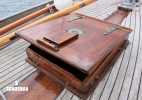
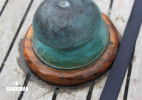
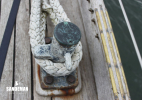
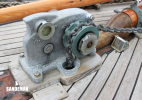
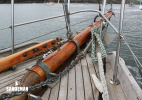

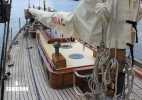
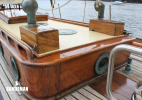
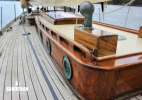
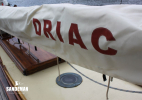
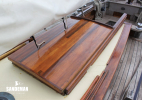
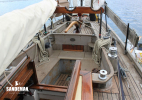
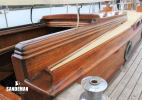
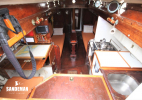
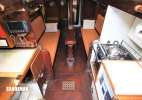
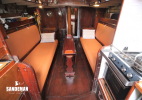
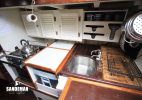
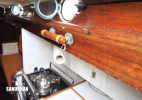
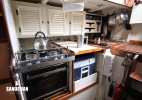
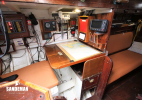
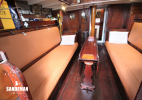
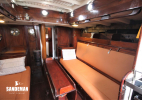
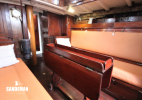
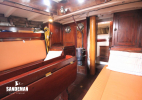
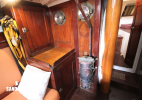
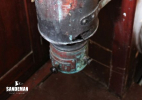
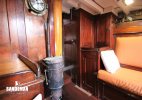
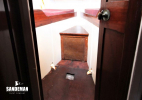
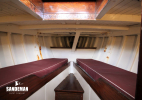
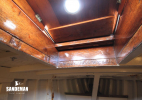
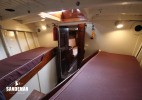
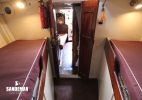
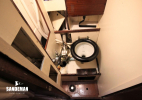
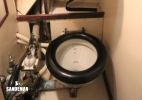
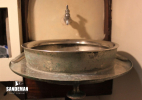
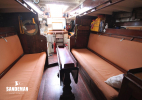
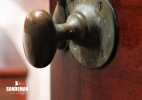
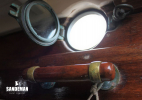
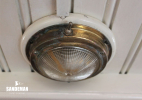
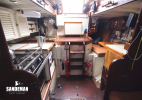
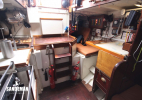
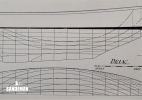
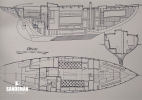

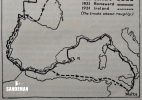
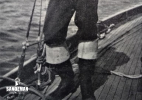

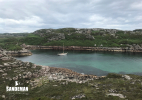
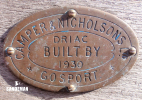
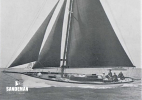
| Designer | Charles E Nicholson |
|---|---|
| Builder | Camper & Nicholsons, Gosport |
| Date | 1930 |
| Length overall | 45 ft 6 in / 13.87 m |
| Length deck | 40 ft 0 in / 12.19 m |
| Length waterline | 30 ft 6 in / 9.3 m |
|---|---|
| Beam | 10 ft 0 in / 3.05 m |
| Draft | 6 ft 3 in / 1.9 m |
| Displacement | 14 Tonnes |
| Construction | Teak on oak and elm |
| Engine | Beta Marine 1505 37.5 hp diesel |
|---|---|
| Location | United Kingdom |
| Price | GBP 68,000 |
These details are provisional and may be amended
Any yacht featured in the superb pre-Second World War series of ‘Uffa Fox books’ is without question a special one, and DRIAC may be best known these days from her inclusion in Fox’s ‘Sailing, Seamanship and Yacht Construction’ (1934). From a time when the design of the ideal offshore sailing cruiser was still evolving and much discussed, Uffa waxed lyrical about this characterful Charles E. Nicholson design which had comfortably reeled off well over 5000 miles in her first two seasons, including Portsmouth to Malta and back, under the command of her redoubtable first owner, A.G.H. Macpherson. DRIAC is still taking people on sailing adventures and, as she has always done, entrances with her looks, presence, and no-nonsense sailing ability.
Interested in DRIAC in more detail.
Driac is a well balanced yacht and sails beautifully. She will make 6-7 knots easily and I once made the 55 mile passage from Kilmore Quay in SE Ireland to Skomer Island at an average of 7.5 knots. She has sailed to the West Coast of Scotland and back five times in my ownership and the Scillies twice. She is often recognised and continually photographed.
"In 1931 the Royal Cruising Club awarded their Challenge Cup to DRIAC and her owner for her cruise of 5000 from Portsmouth to Malta and along the shores of the Mediterranean and home to Portsmouth and so acknowledged that this was the best cruise of the year...
“DRIAC’s lines, like those of PATIENCE and FLAME, also by Charles Nicholson, are easy and sweeping without any hardness, and she has the same full garboards as these two vessels, which besides cutting down wetted surface (which tells so much in beating to windward) give good floor space, so necessary to good accommodation. Her beam, as it naturally should be, in a smaller vessel, is greater in proportion to her length than her larger sisters, for a smaller vessel requires more stability and power from her section; but generally her lines are very like those of PATIENCE and FLAME.
“… DRIAC’s designer, her owner, and she herself help us all in our search for the ideal cruiser and rig, as she is so near to perfection, with her seaworthiness, comfort and speed.”
From ‘Sailing, Seamanship and Yacht Construction’ (1934)
It sounds like it should be from Greek Mythology, but actually it's nothing more simple than the surname name backwards of a highly successful Scottish shipowner who became the principal backer in the late 1920s establishment of the UK's National Maritime Museum at Greenwich, Sir James Caird, 1st Baronet, of Glenfarquhar. (Not to be confused with Sir James Caird, 1st Baronet, of Belmont Castle, a Dundee jute baron and sponsor of Sir Ernest Shackleton's ill-fated Antarctic expedition of 1914 to 1916). DRIAC = CAIRD.
DRIAC's first owner, Arthur George Holdsworth Macpherson (1873-1942) had been brought up in an India Service family, his father a high court judge in Calcutta. Macpherson made his fortune as a stockbroker there, retired at 50 and blew it on his obsession with collecting maritime prints, eventually accumulating a collection of over 11,000 items: a unique record of Britain's maritime past. Caird purchased the collection for the nation for a handsome sum, and after HMS Victory, which he also wholly funded, 'The Macpherson Collection' became an early cornerstone of the Museum's collections.
Part of the purchase price for the collection paid for DRIAC, and thus she got her name.
CAMPER & NICHOLSONS YARD No. 373
DRIAC was launched at the Gosport yard of Camper & Nicholsons on Friday 28th March 1930, by A.G.H. Macpherson’s 10-year-old cousin Shiela B. Macpherson. According to the local press the teak-planked yacht was “practically complete”, and Macpherson seems to have wasted no time in her fit-out, soon setting off on an ambitious summer shakedown cruise of Denmark, including Copenhagen, Norway, Shetland, and the east coasts of England and Scotland.
On return to Gosport in late summer, from experience gained, her locally built McGruer Hollow Spar Company mast and boom were shortened by about two feet (60 cm) each, and then she set off again.
DRIAC’s autumn 1930 cruise was from Portsmouth into the Mediterranean, reaching Malta via the coast of North Africa in time for a Christmas rendezvous with Macpherson's daughter in Valletta. Quite a first season.
The homeward voyage from Malta via the coasts of Italy, France, Spain and Portugal began in early February 1931, the log entertainingly recorded in John Scott Hughes’s 1944 book ‘Macpherson’s Voyages’. Modern-day Mediterranean sailors will recognise the vagaries of the weather recounted there - in which DRIAC’s original 4-cylinder 15 hp Kelvin Ricardo paraffin motor with its Duerr reversing propeller, and storm sail, got alternately well used - but not the tales bureaucratic difficulties in entering ports.
On returning to Portsmouth in July 1931, having let slip they’d been hove-to for three days off Cabo Ortegal, NW Spain, during a gale that caused havoc with the French tunny fleet, Macpherson wouldn’t be drawn by the local press for any tales of derring-do. He countered:
“... what ever you do, don't talk about mountainous waves and that sort of sob stuff, because there is nothing in it provided you have the time and a boat as good and seaworthy as this.”
Macpherson seems to have had just enough time to commission the designing and building of his next yacht before setting off voyaging yet again in August 1931 for a short cruise to south west Ireland. Again, his account of being comfortably hove-to in storm conditions, this time off Cornwall, is well understated, but proves just how able DRIAC is. In his research for ‘Macpherson’s Voyages’, John Scott Hughes discovered that the weather readings at Falmouth during the 23-24 August 1931 storm were steady 70 knots gusting 90. During the same period, Jersey recorded 40 hours of rain, but Macpherson noted, “The only water inside the saloon was what we took there, mostly in our boots, which were full of it.”
Notwithstanding that DRIAC ticked all of Macpherson’s boxes, he was a man advancing in his 60s contemplating a short-handed circumnavigation. He was convinced he needed a boat with all DRIAC’s abilities, but much smaller. The resulting Sidney N. Graham-designed, Harry Feltham of Portsmouth-built DRIAC II, launched in 1932, was like a 32ft replica.
Ownership in DRIAC [I] transferred in September 1932 to William R. Macpherson of Alverstoke, Hampshire, presumed to be the first owner's cousin. There then followed a series of short ownerships through the mid-1930s:
- 1932 Warren Lloyd Ferrier, Torquay
- 1933 William Andrew Rome, possibly moored Burnham-on-Crouch
Name changed to MARLIN
- 1935 Arthur Emilius David Anderson
- 1935 Warren Lloyd Ferrier, Torquay
In 1936 DRIAC was bought by London stockbroker and Royal Ocean Racing Club member Matthew Hackforth-Jones (brother of once popular children's' sailing adventure story author of the 'Green Sailors' series, Gilbert Hackforth-Jones) who reverted her name to the original and owned her until 1959. Moored on the Solent, possibly at Lymington, she was photographed by Beken in 1937. Under Hackforth-Jones's ownership, another side of DRIAC's talents emerged. No Charles Nicholson design would ever be slow: she was raced extensively and with some success in the vibrant late 1930s RORC offshore scene:
Channel Race 1936
- 2nd (200 miles heavy weather)
Coronation Race 1937
- 3rd in Cruiser Class
Cherbourg Race 1937
Dinard Race 1937
Cherbourg Race 1938
Dinard Race 1938
Round the Island Race 1938
Then:
- 1959 Major Melvyn S.B. Vernon, M.V.O., Royal Yacht Squadron
From 1960 to 1978 (Later Sir) Frederic E. Harmer & James A. Hill moored DRIAC at Aldeburgh, Suffolk. Harmer was UK Government Representative on the board of British Petroleum; later Deputy Chairman of P&O Shipping through the containerisation revolution. During their ownership, DRIAC crossed the North Sea for a return to Baltic waters and she is known to have cruised at least as far east as the Åland Islands between Sweden and Finland.
Then:
- 1978 Barrie Meller, a Dorset boatbuilder, port Wareham
- 1982 Barry Clegg, Somerset
- Uncertain period
- c2001 Chris Brackley, Exeter
In present ownership since 2008, DRIAC has been a busy development training charter vessel and a participant in the Three Peaks Yacht Race 2009, 2010, 2013, 2021, and the Scottish Islands Peaks Race in 2012.
©2025 Iain McAllister/ Sandeman Yacht Company Ltd
- Carvel teak planks copper clench fastened to sistered grown/ sawn oak frames
- Steamed intermediate Canadian rock elm/ oak timbers bronze screw fastened
- Elm keelson; oak stem, sternpost and horn timber
- Oak beamshelf; pitch pine deck beams
- Oak lodging knees, iron hanging knees
- Bronze bolts securing iron floors
- 5 Ton lead keel secured by 1¼ in (32 mm) bronze bolts 2 ft 6in (76 cm) long
- Iroko deck (1982)
- Underbody Cascover sheathed to a high specification (1978)
- Teak coachroof sides; iroko roof, sheathed
2019
- Engine removed to workshop
- Grease-filled stern tube removed, re-machined with new bearings; reinstalled
- Engine remounted and re-aligned
2015
- Major structural refit to keel, frames, floors and fastenings to ensure her future strength
- Meeting strength, seaworthiness and equipment requirements of commercial coding
- Engine, fuel and filter system refit to comply with MCA SCV code
- New standing and running rigging
2009
- Structural work in present ownership
1982
- Re-decked in Iroko
1978
- Sheathed with Cascover to a high specification
FROM AFT
- Raw iroko laid deck
- Raw teak covering board and rail
- Varnished counter fashion board, and king plank
AFT DECK
- Painted pushpit
- Bronze fairleads port and starboard
- Teak Dorade box with bronze cowl
- Gas bottle with tan acrylic cover on wood shelf at pushpit
- Deck fittings and taffrail exits for the Aries self-steering
- Galvanized, bronze topped mooring bollards port and starboard
- Laminated tiller with bronze fittings
- Removable boom gallows
SMALL, DEEP COCKPIT
- As specified by Macpherson for bad weather
- 2 x Cockpit drains
- Raw teak coaming
- Teak seating port, starboard and aft; lockers under
- Well positioned engine control
- Depth readout and steering compass
- Whale manual bilge pump
- 2 x ‘D’ rings for crew to clip into, one at companionway
- Lewmar mainsheet winch aft
- 4 x Lewmar self-tailing cockpit sheet winches on teak plinths
- (2 x Lewmar 16 aft)
- (2 x Lewmar 34 fwd)
- 4 x Associated raw teak cleats
- Tufnol mainsheet blocks
- 2 x Lewmar 8 winches fwd cockpit coaming for preventers
SIDE DECKS
- Galvanised Highfield runner levers port and starboard
- Associated galvanised deck leads
- Lewmar jib cars and tracks
- Tufnol headsail sheet blocks
- Forward track and car for working jib
COACHROOF
- Low profile and massively built
- Varnished teak uprights and margins
- 8 x Port lights
- Plywood roof with light yellow polyester-glassed top
- To appear like canvas (to eliminate leaks)
- Sliding companionway hatch in varnished teak
- Slides into varnished teak garage
- Substantial varnished teak single washboard
- Teak handrails port and starboard
- 2 x Deck lights
- 2 x Varnished teak Dorade boxes with bronze cowls
- 2 x Bronze and tufnol halyard winches
- Stainless steel granny bar/ liferaft frame at mast base
MAST POSITION
- Galvanised bottle screws
- 2 x Spreader mainmast
- Galvanised spiderband pin rail at base of mast
FOREDECK
- Tufnol blocks for staysail fwd of mast
- Raised varnished teak hatch over forecabin
- 2 x Bronze mushroom vents
- 2 x Galvanised mooring bollard
- Simpson Lawrence Sea Tiger 2-speed manual windlass
- Chain gipsy and warping drum
- Stainless steel bowsprit bit
- Bronze cranse iron
- Bowsprit with traveller
- 'Dyarchy' stay for working jib
- Stainless steel pulpit
- Galvanised forestsay bottle screw
- Staysail boom pivoted on bowsprit with continuous sheet
- 15 kg/ 35lb CQR anchor on bow roller to starboard
- 70 m 10 mm High tensile chain
- 30 m 8 mm Chain
- Spare 30kg/ 66lb CR anchor stowed below
- Spare fisherman anchor stowed below
- Bronze fairlead to port
ENTRY VIA COMPANIONWAY, ENGINE BOX AND 3 x STEPS
- Engine access above and fwd
TO ACCOMMODATION UNDER COACHROOF
- 8 x Opening ports
- 2 x Non opening ports in deckhead
- 3 x Teak/ bronze hand holds
- LED Reading lights
- LED Deckhead lights
GALLEY TO STARBOARD
- Stainless steel sink
- Hot, cold and sea water taps
- Work surface
- Plate racks
- Cool box
- Dometic 3 x burner hob with oven and grill
FWD FACING CHART TABLE TO PORT AND QUARTER BERTH
- Folds down to create quarter berth
- Drawer under
- Bookcase
- Electrical isolator panel
- VHF Radio
- Beta engine controls
- Log
- Navtex
- Depth
- GPS Plotter with AIS feed
- Chart table light
SALOON
- 7 Ft / 2.13 m headroom
- Mostly original mahogany carpentry
- Settee berths port and starboard
- Back-rests lower with lockers behind
- Shelving outboard
- Stowage under berths
- Mahogany salon table
- Sideboards with fiddled tops port and starboard
- Pascall Atkey Pansy copper charcoal stove at port fwd bulkhead
- Removeable 1 in / 25 mm flue
- Clock and barometer
FORWARD TO LOBBY
WET LOCKER TO STARBOARD
WC COMPARTMENT TO PORT
- Baby Blake sea toilet
- 2 x Anti-siphon loops
- 2 x Blakes bronze seacocks (2009)
- Period folding wash basin
- Supplied by footpump
- Dedicated stainless steel water tank under fo'c'sle sole
- Lockers
- Bulkhead light
- Deck light
FORECABIN
- Entry via double mahogany doors
- Single berths port and starboard
- Sail lockers under
- Raised forehatch in deckhead
- 2 x Reading lights
- Access fwd to chain and paint locker
SPARS
- 55 ft/ 17 m Spruce mast
- Believed to be the original by McGruer Hollow Spar Co., Gosport
- 2 x Pairs laminated larch spreaders (2010)
- Traditionally served spliced galvanised steel wire standing rigging (2015)
- Running backstays with highfield levers operated from cockpit
- Bronze track (2009)
- External wiring (2009)
- Masthead VHF antenna, anchor, and tri-colour light
- Radar reflector on front of mast near top
- Steaming light and deck light fitting at ½ height
- 2 x Tufnol & bronze halyard winches
- 1 x Smaller Tufnol & bronze winch at front
- Boom with 3 x slab reefing pennants on port side
- Small Tufnol & bronze winch for first reef
- Preventer rigged to underside of boom in readiness
- Wood whisker pole in deck chocks to port; fitting on front of mast
- Running rigging mostly in buff polyester
SAILS
Dacron sails in traditional style by James Lawrence Sailmakers (2012)
- Mainsail
- Boomed staysail
- Working jib on bowsprit traveller
- Jib topsail
Older Dacron sails
- Large genoa
- Storm trysail
- Storm jib
CANVASWORK
- New mainsail cover with name (2015)
- Boom tent (2015)
- Cringles to attach the flexible solar panel when the boat is unattended
- Forehatch cover
- Gas bottle cover
NAVIGATION/ ELECTRONICS
- Nasa water log
- Nasa depth sounder
- Nasa navtex
- AIS engine and signal splitter (Shares VHF antenna)
- Standard Horizon chart plotter with AIS feed
- Jeppeson C-Map (Europe and GB)
COMMUNICATIONS
- Icom waterproof DSC marine VHF radio
- Handheld VHF radio and charger
- Beta Marine 1505 37.5 hp diesel (2003, c900 hrs)
- Engine-in seacock under sole
ELECTRICAL
- Batteries in box compartment above/beside engine
- 1 x Lead-acid cranking battery, separately switched
- 2 x Deep-cycle 110 Ah domestic batteries, separately switched
- 240 V-12 V Charger mounted with batteries; cable for shore power
TANKAGE
Water
- Galley water in 2 x Plastimo bag tanks under saloon sole: 120 L & 200 L
- WC Compartment water under sole, 50 L stainless steel
Hot Water
- 20 L calorifier to starboard of engine
- Jabsco 12 V demand pump for hot water tap
Fuel
- Tanks either side of cockpit: 2 x 130 L
- Each with a water separator filter in engine compartment
- Behind engine are 2 Blakes bronze seacocks for cockpit drains
- Operated by a long handled tool
- Automatic electric bilge pump below sole
- Whale Gusher hand pump
- Jackstays either side from bow to aft end of cockpit
- 2 x Horseshoe lifebuoys with name and port of registry
- 2 x Automatic LED MOB lights
- 1 x Danbuoy
- 1 x Oscar Lifesling for trailing
- Offshore flarepack (4 rockets, 4 pinpoints, 2 smokes)
- Emergency VHF antenna
- 6 x Halkey Roberts 170N auto lifejackets with lights and spray hoods
- 6 x Tethers
- Seasafe 6-person liferaft with 24 hour pack mounted
- Hydrostatic release
- 5 x Fire extinguishers of various types
- 1 x Fire blanket at galley
- 2 x Fire buckets
- Gas alarm and bilge detector
- Carbon monoxide detector
Grab box with:
- 5 x Thermal Protective Aids
- Cat C first aid kit
- Spare food and water
- Inflatable radar reflector
- Aries self-steering
- Large stock of Baby Blake WC spares
- Torqeedo Travel 503S electric outboard motor
Contact us to discuss DRIAC in more detail.

| Name | AMAZON |
|---|---|
| Designer | Sparkman & Stephens |
| Builder | Camper & Nicholsons, Southampton |
| Date | 1972 |
| Length deck | 72 ft 7 in / 22.12 m |
| Beam | 17 ft 0 in / 5.18 m |
| Draft | 10 ft 3 in / 3.12 m |
| Displacement | 47 Tons |
| Location | Spain |
| Price | Sold |
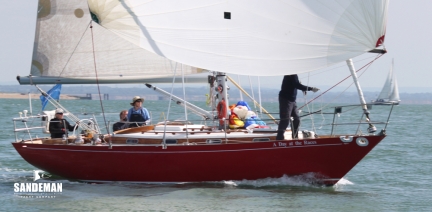
| Name | A DAY AT THE RACES (EX YEOMAN XIV) |
|---|---|
| Designer | Peter Nicholson |
| Builder | Camper & Nicholsons, Southampton |
| Date | 1966 |
| Length deck | 35 ft 1 in / 10.7 m |
| Beam | 9 ft 10 in / 3 m |
| Draft | 5 ft 11 in / 1.8 m |
| Displacement | 7.24 Tons |
| Location | United Kingdom |
| Price | GBP 75,000 |
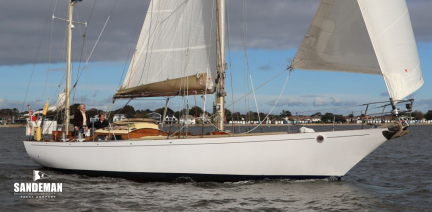
| Name | MUSKETEER OF STUTTON |
|---|---|
| Designer | Peter Nicholson/ Camper & Nicholsons |
| Builder | Camper & Nicholsons, Southampton |
| Date | 1963 |
| Length deck | 46 ft 4 in / 14.12 m |
| Beam | 11 ft 6 in / 3.5 m |
| Draft | 7 ft 6 in / 2.29 m |
| Displacement | 16 Tons |
| Location | United Kingdom |
| Price | GBP 58,500 |
These particulars have been prepared from information provided by the vendors and are intended as a general guide. The purchaser should confirm details of concern to them by survey or engineers inspection. The purchaser should also ensure that the purchase contract properly reflects their concerns and specifies details on which they wish to rely.